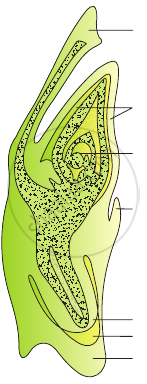Advertisements
Advertisements
Question
Explain the development of dicot embryo.
Solution

A: Oospore.
B: Two celled proembryo.
e: embryonal initial;
t: suspensor initial;
m: Embryo sac membrane.
B1 : 4-celled I-shaped proembryo;
e1, e2: embryonal initial; s1, s2 : suspensor initial.
C: Further development of embryo.
S: Suspensor, h: Hypophysis; E: Embryonal mass
D: L. S. of ovule
Endo: Endosperm in free nuclear stage.
Anti: Antipodal tissue.
Embryo: Developing embryo
E: Embryo showing further development of embryonic octants and hypophysis.
F: L. S. of ovule. Endosperm becoming cellular.
G: Embryo; Cot: Cotyledons; Hypo: Hypocotyl; Rad: Radicle; R.c.: Rootcap;
H: Mature seed; Pl: Plumule. Endosperm has been consumed almost completely
Development of dicot embryo:
- The zygote divides to form two-celled proembryo.
- The larger cell towards the micropyle is called basal or suspensor initial cell and smaller cell towards chalaza is called terminal or embryonal initial cell.
- The suspensor cell divides transversely in one plane to produce filamentous suspensor of 6-10 cells.
- The first cell of the suspensor towards the micropylar end becomes swollen and functions as a haustorium.
- The lowermost cell of the suspensor is known as hypophysis.
- The suspensor helps in pushing the embryo in the endosperm.
- The embryonal initial undergoes three successive mitotic divisions to form octant.
- The planes of divisions are at right angles to each other.
- The lower tier of four cells of octant gives rise to hypocotyl and radicle whereas four cells of the upper-tier form the plumule and the one or two cotyledons.
- The hypophysis by further division gives rise to the part of the radicle and root cap.
- Subsequently, the cells in the upper tier of the octant divide into several planes so as to become heart-shaped which then forms two lateral cotyledons and a terminal plumule.
- Further enlargement of hypocotyl and cotyledons result in a curvature of the embryo and it appears horseshoe-shaped.
APPEARS IN
RELATED QUESTIONS
Write the function of the following:- (Oviducal) Fimbriae
Very short answer type question:
Name the parts of pistil which develop into fruits and seeds.
Describe the development of dicot embryo in flowering plants.
From the following identify the non endospermic seeds.
In a type of apomixis known as adventive embryony, embryos develop directly from the ______.
Coleoptile and coleorhiza are the protective sheaths covering ______ and ______ respectively.
Embryo development takes place at ______.
In the embryos of a typical dicot and a grass, true homologous structures are ______.
In the given diagram, write the names of parts shown with lines.

Starting with the zygote, draw the diagrams of the different stages of embryo development in a dicot.
